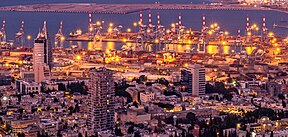
Back Haifa Afrikaans Haifa ALS Haifa AN حيفا Arabic ܚܝܦܐ ARC حيفا ARZ Haifa AST Hayfa Azerbaijani حیفا AZB Хайфа Bashkir
Haifa
| |
|---|---|
 Map of Haifa | |
| Coordinates: 32°49′09″N 34°59′57″E / 32.81917°N 34.99917°E | |
| Grid position | 145/246 PAL |
| Country | |
| District | |
| Founded | 1st century CE |
| Government | |
| • Mayor | Einat Kalisch-Rotem |
| Area | |
| • City | 63,666 dunams (63.666 km2 or 24.582 sq mi) |
| Population (2022)[1] | |
| • City | 290,306 |
| • Density | 4,600/km2 (12,000/sq mi) |
| • Urban | 600,000 |
| • Metro | 1,050,000 |
| Website | www.haifa.muni.il |
Haifa (/ˈhaɪfə/ HY-fə; Hebrew: חֵיפָה, romanized: Ḥēyfā, IPA: [ˈχajfa]; Arabic: حَيْفَا, romanized: Ḥayfā)[2] is the third-largest city in Israel—after Jerusalem and Tel Aviv—with a population of 290,306 in 2022. The city of Haifa forms part of the Haifa metropolitan area, the third-most populous metropolitan area in Israel.[3] It is home to the Baháʼí Faith's Baháʼí World Centre, and is a UNESCO World Heritage Site and a destination for Baháʼí pilgrimage.[4]
Built on the slopes of Mount Carmel, the settlement has a history spanning more than 3,000 years. The earliest known settlement in the vicinity was Tell Abu Hawam, a small port city established in the Late Bronze Age (14th century BCE).[5] In the 3rd century CE, Haifa was known as a dye-making center. Over the millennia, the Haifa area has changed hands: being conquered and ruled by the Canaanites, Israelites, Phoenicians, Assyrians, Babylonians, Persians, Hasmoneans, Romans, Byzantines, Arabs, Crusaders, Ottomans, and the British. During the Battle of Haifa in the 1948 Palestine war, most of the city's predominantly Arab population fled or were expelled. That year, the city became part of the then-newly-established state of Israel.
As of 2016[update], the city is a major seaport located on Israel's Mediterranean coastline in the Bay of Haifa covering 63.7 km2 (24.6 sq mi). It lies about 90 km (56 mi) north of Tel Aviv and is the major regional center of northern Israel. Two respected academic institutions, the University of Haifa and the Technion – Israel Institute of Technology the oldest and top ranked university in both Israel and the Middle East, are located in Haifa, in addition to the largest K–12 school in Israel, the Hebrew Reali School. The city plays an important role in Israel's economy. It is home to Matam, one of the oldest and largest high-tech parks in the country; and prior to the opening of Tel Aviv Light Rail, Haifa is the only city with underground rapid transit system in Israel known as the Carmelit.[6][7] Haifa Bay is a center of heavy industry, petroleum refining and chemical processing. Haifa formerly functioned as the western terminus of an oil pipeline from Iraq via Jordan.[8] It is one of Israel's mixed cities, with an Arab-Israeli population of c.10%.
- ^ "Regional Statistics". Israel Central Bureau of Statistics. Retrieved 21 March 2024.
- ^ Cite error: The named reference
Bosworthwas invoked but never defined (see the help page). - ^ "Localities, population and density per sq. km., by metropolitan area(1) and selected localities 2019" (PDF). Central Bureau of Statistics. 15 September 2020. Archived (PDF) from the original on 26 April 2021. Retrieved 26 April 2021.
- ^ UNESCO World Heritage Centre (8 July 2008). "Three new sites inscribed on UNESCO's World Heritage List". Archived from the original on 10 July 2008. Retrieved 8 July 2008.
- ^ Encyclopedia Judaica, Haifa, Keter Publishing, Jerusalem, 1972, vol. 7, pp. 1134–1139
- ^ "GavYam". Gav-Yam.co.il. Archived from the original on 15 April 2008. Retrieved 18 February 2008.
- ^ "Carmelit Underground Train, Haifa". touristisrael.com. 5 February 2012. Archived from the original on 20 September 2016. Retrieved 19 September 2016.
- ^ Cohen, Amiram. "U.S. Checking Possibility of Pumping Oil from Northern Iraq to Haifa, via Jordan". Haaretz. Archived from the original on 3 June 2008. Retrieved 6 December 2008.
© MMXXIII Rich X Search. We shall prevail. All rights reserved. Rich X Search











